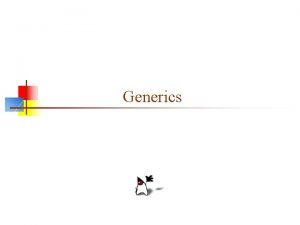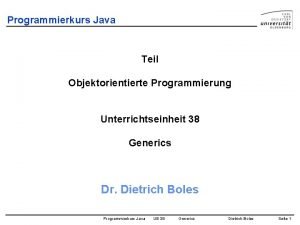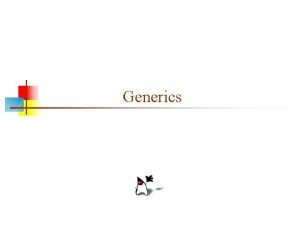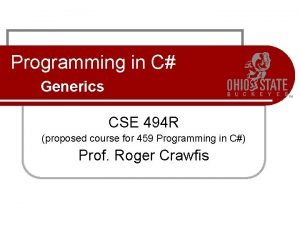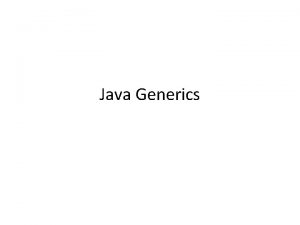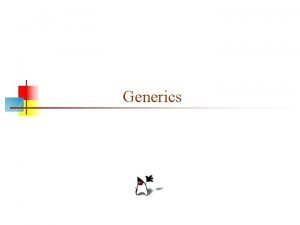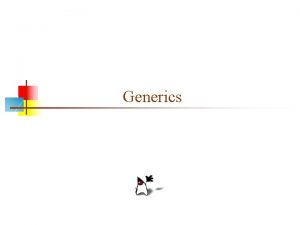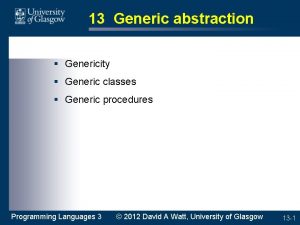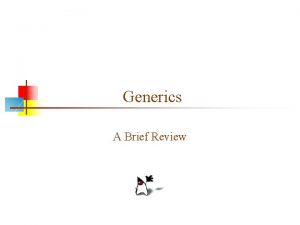Java Generic Class without Generics Java Generics 1















- Slides: 15

Java Generic Class without Generics Java Generics 1 A buffer pool is a data structure that caches records retrieved from a disk file, in order to improve an application's performance. Typically, the pool stores some sort of data object together with the offset where that record occurs in the disk file. The data objects could be of just about any type, and we hate to write duplicate classes, so we'd like to write a single class to encapsulate the file offset and the data object: public class BPEntry { private Long Offset; private Object Value; // could be of any type! public BPEntry(Long offset, Object value) { Offset = offset; Value = value; } Well. . . that's flexible. . . maybe too flexible. . CS@VT Data Structures & Algorithms © 2010 -2020 WD Mc. Quain

Java Generic Class without Generics Java Generics 2 Suppose that we have a file of records that could be represented by String objects: . . . Long offset = raf. get. File. Pointer(); String record = raf. read. Line(); BPEntry bp = new BPEntry(offset, record); // OK But suppose we made the following mistake: . . . BPEntry bp = new BPEntry(offset, offset); // ? ? This will compile and run since Long is a subtype of Object. . . using Object eliminates any type-checking at compile time. . . CS@VT Data Structures & Algorithms © 2010 -2020 WD Mc. Quain

Simple Formal Java Generic Class Java Generics 3 public class BPEntry<T> { private Long Offset; private T Value; public BPEntry(Long offset, T value) { Offset = offset; Value = value; }. . . Now. . . Long offset = raf. get. File. Pointer(); String record = raf. read. Line(); BPEntry<String> bp = new BPEntry<String>(offset, record); // OK But this will not compile: . . . bp = new BPEntry<String>(offset, offset); // incompatible types! CS@VT Data Structures & Algorithms © 2010 -2020 WD Mc. Quain

Improved Version? Java Generics 4 The current version limits us to using Longs for the offset field, but if the file is small then the offset could be an Integer (and save memory). We can try to improve the flexibility: public class BPEntry<K, T> { private K Offset; private T Value; public BPEntry(K offset, T value) { Offset = offset; Value = value; }. . . But now, a careless user could specify a non-numeric type for the offset: . . . bp = new BPEntry<String, Integer>(record, offset); CS@VT Data Structures & Algorithms © 2010 -2020 WD Mc. Quain

Final Version Java Generics 5 We can place a restriction on the type parameter (a bound in Java terms): public class BPEntry<K extends Number, T> { private K Offset; private T Value; public BPEntry(K offset, T value) { Offset = offset; Value = value; }. . . Now the user cannot use a non-numeric type for the offset. But a user could still specify a non-integer type, which would be illogical. . . CS@VT Data Structures & Algorithms © 2010 -2020 WD Mc. Quain

An equals() method with Generics Java Generics 6 public class BPEntry<K extends Number, T> {. . . public boolean equals(Object other) { if ( other == null ) return false; if ( !this. get. Class(). equals(other. get. Class()) ) { return false; } BPEntry<K, T> obj = ( BPEntry<K, T> ) other; return ( this. Key. equals(obj. Key) ); }. . . CS@VT Data Structures & Algorithms © 2010 -2020 WD Mc. Quain

Simple Generic Method Java Generics 7 The contains() method can be used to search an array holding objects of any type. public static <T> boolean contains( T[] array, T x) { for ( T value : array ) { if ( x. equals(value) ) return true; } return false; } Integer[] array = new Integer[10]; for (int pos = 0; pos < 10; pos++) { array[pos] = pos * pos; } if ( contains( array, 15 ) ) { System. out. println("Found value in array. "); } else { System. out. println("Could not find value in array. "); } CS@VT Data Structures & Algorithms © 2010 -2020 WD Mc. Quain

The Need for Type Bounds Java Generics 8 public static <T> T find. Max( T[] array) { int max. Index = 0; for ( int i = 1; i < array. length; i++) { if ( array[i]. compare. To(array[max. Index]) > 0 ) max. Index = i; } return array[max. Index]; } Z: GenericsFind. Max 1 > javac -Xlint ex. Find. Max 1. java: 20: error: cannot find symbol if ( array[i]. compare. To(array[max. Index]) > 0 ) ^ symbol: method compare. To(T) location: class Object where T is a type-variable: T extends Object declared in method <T>find. Max(T[]) 1 error Problem: There is no way for the Java compiler to know that the generic type T will represent an actual type that implements the method compare. To() used in the test within the loop. So, this will not do… CS@VT Data Structures & Algorithms © 2010 -2020 WD Mc. Quain

Applying a Type Bound Java Generics 9 public static <T extends Comparable<T> > T find. Max( T[] array) { int max. Index = 0; for ( int i = 1; i < array. length; i++) { Type bound if ( array[i]. compare. To(array[max. Index]) > 0 ) max. Index = i; } return array[max. Index]; } This restricts the type parameter T to be a type that implements the interface Comparable<T>, guaranteeing that the call to compare. To() is valid. CS@VT Data Structures & Algorithms © 2010 -2020 WD Mc. Quain

Problem with the Fix Java Generics 10 public static <T extends Comparable<T> > T find. Max( T[] array) { int max. Index = 0; for ( int i = 1; i < array. length; i++) { if ( array[i]. compare. To(array[max. Index]) > 0 ) max. Index = i; } return array[max. Index]; } Problem: Suppose that Shape implements Comparable<Shape>, and that Square extends Shape, so that we know Square implements Comparable<Shape>. Then Square would not satisfy the condition used above, even though the necessary method is, in fact, available. So, this will not do… in certain cases… CS@VT Data Structures & Algorithms © 2010 -2020 WD Mc. Quain

A Better Fix Java Generics 11 public static <T extends Comparable<? super T> > T find. Max( T[] array) { int max. Index = 0; for ( int i = 1; i < array. length; i++) { if ( array[i]. compare. To(array[max. Index]) > 0 ) max. Index = i; } return array[max. Index]; } We need a restriction that allows T to be derived from a superclass that provides the implementation of Comparable()… The bound used here does so… CS@VT Data Structures & Algorithms © 2010 -2020 WD Mc. Quain

The Fix Explained Java Generics 12 public static <T extends Comparable<? super T> > T find. Max( T[] array) {. . . } Wildcards: The symbol '? ' is a wildcard. A wildcard represents an arbitrary class, and is followed by a restriction. In this case, the restriction is that the arbitrary class must be a superclass of T. So, this says that T must extend a base class X which is-a Comparable<X>. So, T implements the required method and all is well. CS@VT Data Structures & Algorithms © 2010 -2020 WD Mc. Quain

Limitation: Type Erasure Java Generics 13 The compiler translates generic and parameterized types by a technique called type erasure. Basically, it elides all information related to type parameters and type arguments. For instance, the parameterized type List<String> is translated to type List , which is the so-called raw type. The same happens for the parameterized type List<Long> ; it also appears as List in the bytecode. After translation by type erasure, all information regarding type parameters and type arguments has disappeared. As a result, all instantiations of the same generic type share the same runtime type, namely the raw type. Angelika Langer's FAQ CS@VT Data Structures & Algorithms © 2010 -2020 WD Mc. Quain

Consequences of Type Erasure Java Generics 14 The use of type erasure limits the usefulness* of formal Java generics. For example: public class Foo<T> { private T[] array; // fine public Foo(int Sz) { array = new T[Sz]; } } Illegal: When the code is compiled, T will be replaced by its bound (which may be merely Object). The compiler also auto-generates a typecast for the return value from new. The typecast will fail because Object[] is-not-a T[]. *vs C++ templates CS@VT Data Structures & Algorithms © 2010 -2020 WD Mc. Quain

How to Cheat. . . Java Generics 15 public class Hash. Table<T extends Hashable> { T[] Table; . . . public Hash. Table(int Sz, probe. Option Opt) {. . . Table = (T[]) new Hashable[Sz]; . . . Allocate array of an appropriate "concrete" type Typecast to the generic type. . . The price is that this typecast will generate a warning since the compiler cannot know that this will be safe. CS@VT Data Structures & Algorithms © 2010 -2020 WD Mc. Quain
 Java generic array
Java generic array Generics java erklärung
Generics java erklärung Benefits of generics in java
Benefits of generics in java Java generics array
Java generics array System.collections.generics
System.collections.generics Hospitality generics
Hospitality generics Kotlinx serialization generics
Kotlinx serialization generics C generics
C generics Without title by diane glancy
Without title by diane glancy Diane glancy without title
Diane glancy without title Without rush without engines poetic device
Without rush without engines poetic device Generic communication model
Generic communication model Generic linked list in c
Generic linked list in c Today's class work
Today's class work Package mypackage; class first { /* class body */ }
Package mypackage; class first { /* class body */ } Introduction to ooad
Introduction to ooad
